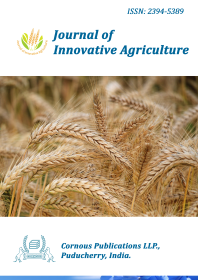
Journal of Innovative Agriculture
Peer Reviewed Open Access Journal
ISSN: 2394-5389 NAAS: 4.05
Submit Manuscript
Peer Reviewed Open Access Journal
ISSN: 2394-5389 NAAS: 4.05
Submit ManuscriptIncreasing costs in the agricultural sectors is nowadays with the use of herbicides on weeds control that need to use non chemical methods to reduce the environmental impact of chemical herbicide, insecticides and weedicide to prevent weed resistance, use of allelochemical natural herbicide for weed control to reduce the costs. In integrated weed management programs allelopathic chemicals as an alternative for weeds control. These chemicals inhibit the weeds growth and as a weapon to be used against these unwanted plants. Allelopathic crops species relationship, genetic diversity is very extreme and genetic control of these compounds to be seems. The main aims of this review paper are to find out the efficient allelopathic nonchemical control of weeds from crops and best way of controlling the noxious weeds with these plants extract.
allelopathic, chemicals, crops, weeds, weed control, environment, herbicide, plant extract
Aliotta, G. & Cafiero, G. (1999). Biological properties of Ruta graveolens and its potential use in sustainable agricultural systems. Pp: 551-563.
Baybordi, M., Malakouti, M., Mokri, H., & Nafisi, M. (2000). Fertilizer production and efficiency goals of sustainable agriculture. Agricultural Education Press. Karaj, Iran.
Chung, I. M., Kim, K. H., Ahn, J. K., Lee, S. B., Kim, S. H., & Hahn, S. J. (2003). Comparison of allelopathic potential of rice leaves, straw, and hull extracts on barnyardgrass. Agronomy Journal, 95(4), 1063-1070.
Cipollini, D. (2016). A review of garlic mustard (Alliaria petiolata, Brassicaceae) as an allelopathic plant. The Journal of the Torrey Botanical Society, 143(4), 339-348.
Dilday, R. H., Yan, W. G., Moldenhauer, K. A. K., & Gravois, K. A. (1998). Allelopathic activity in rice for controlling major aquatic weeds. Allelopathy in rice, 7-26.
Douglass, C. H., Weston, L. A., & Wolfe, D.W.(2011). Phytotoxicity and potential allelopathy in pale (Cynanchum rossicum) and black swallowwort (C. nigrum). Invasive Plant Science and Management, 4(1), 133-141.
Fenwick, G. R., Heaney, R. K., Mullin, W. J., & VanEtten, C. H. (1983). Glucosinolates and their breakdown products in food and food plants. CRC Critical Reviews in Food Science and Nutrition, 18(2), 123-201.
Ferreira, M. I., & Reinhardt, C. F. (2010). Field assessment of crop residues for allelopathic effects on both crops and weeds. Agronomy Journal, 102(6), 1593-1600.
Fujii, Y. (2001). Screening and future exploitation of allelopathic plants as alternative herbicides with special reference to hairy vetch. Journal of Crop Production, 4(2), 257-275.
Gliessman, S. R. (1987). Species interactions and community ecology in low external-input agriculture. American Journal of Alternative Agriculture, 2(4), 160-165.
Guenzi, W. D., & McCalla, T. M. (1966). Phenolic acids in oats, wheat, sorghum, and corn residues and their phytotoxicity 1. Agronomy Journal, 58(3), 303-304.
Halsey, A. H. (2004). A history of sociology in Britain: science, literature, and society. Oxford University Press.
Inam, B., Hussain, F., & Bano, F. (1989). Cannabis sativa L. is allelopathic. Pakistan Journal of Scientific and Industrial Research (Pakistan), 32(9).
Koochaki, A.S., Nakh, F.A.S. & Zarif, K.C. (1997). Agriculture organic (translation). Ferdowsi University of Mashhad Press.
Lin, W., Fang, C., Chen, T., Lin, R., Xiong, J., & Wang, H. (2010). Rice allelopathy and its properties of molecular ecology. Frontiers in Biology, 5(3), 255-262.
Mighati, P. (2003). Allelopathy from concept to application. Publications of the incident beam. PP, 256.
Miller, D. A. (1996). Allelopathy in forage crop systems. Agronomy Journal, 88(6), 854-859.
Muller, C. H., Muller, W. H., & Haines, B. L. (1964). Volatile growth inhibitors produced by aromatic shrubs. Science, 143(3605), 471-473.
Murrell, C., Gerber, E., Krebs, C., Parepa, M., Schaffner, U., & Bossdorf, O. (2011). Invasive knotweed affects native plants through allelopathy. American Journal of Botany, 98(1), 38-43.
Mushtaq, M. N., Cheema, Z. A., Khaliq, A., & Naveed, M. R. (2010). A 75% reduction in herbicide use through integration with sorghum+ sunflower extracts for weed management in wheat. Journal of the Science of Food and Agriculture, 90(11), 1897-1904.
Navarez, D., & Olofsdotter, M. (1996). Allelopathic rice for Echinochloa crus-galli control. In Proceeding of the 2nd International Weed Control Congress, Copenhagen, Denmark (pp. 1175-1181).
Niemeyer, H. M. (1988). Hydroxamic acids (4-hydroxy-1, 4-benzoxazin-3-ones), defence chemicals in the Gramineae. Phytochemistry, 27(11), 3349-3358.
Oueslati, O. (2003). Allelopathy in two durum wheat (Triticum durum L.) varieties. Agriculture, ecosystems & environment, 96(1-3), 161-163.
Perry, L. G., Cronin, S. A., & Paschke, M. W. (2009). Native cover crops suppress exotic annuals and favor native perennials in a greenhouse competition experiment. Plant Ecology, 204(2), 247-259.
Pester, T. A., Westra, P., Anderson, R. L., Lyon, D. J., Miller, S. D., Stahlman, P. W., ... & Wicks, G. A. (2000). Secale cereale interference and economic thresholds in winter Triticum aestivum. Weed Science, 48(6), 720-727.
Petersen, J., Belz, R., Walker, F., & Hurle, K. (2001). Weed suppression by release of isothiocyanates from turnip‐rape mulch. Agronomy Journal, 93(1), 37-43.
Putnam, A. R. (1985). Allelopathic research in agriculture, in the chemistry of allelopathy, Biochemical interaction among plants, Thompson,. C., Ed. Ameri. Chemi. Soci., Washington, 216-224.
Rahimiyan, H., Koochaki, A.S., Nassiri, H. & Khiyabani, H. (1994). Weed Ecology (translation). Jahad Mashhad University Press, Pp: 327.
Rice, E. L. (1984). Allelopathy. 2nd (ed.) Academic Press. Inc. Orlando. Florida, USA, 266-291.
Rimando, A. M., Olofsdotter, M., Dayan, F. E., & Duke, S. O. (2001). Searching for rice allelochemicals: An example of bioassay‐guided isolation. Agronomy Journal, 93(1), 16-20.
Singh, H. P., Batish, D. R., & Kohli, R. K. (2001). Allelopathy in Agroecosystems: An Overview. Journal of Crop Production, 4(2), 1–41. https://doi.org/10.1300/J144v04n02_01.
Turk, M. A., & Tawaha, A. M. (2003). Allelopathic effect of black mustard (Brassica nigra L.) on germination and growth of wild oat (Avena fatua L.). Crop protection, 22(4), 673-677.
Weston, L. A. (1996). Utilization of allelopathy for weed management in agroecosystems. Agronomy journal, 88(6), 860-866.
